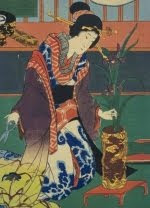Moribana, abstract freestyle.
Stones, shoelaces, pine and moss.
Stones, shoelaces, pine and moss.
Decorative knots is one of many nice features of Japanese hospitality. You'll find them on gift wrappings and in ornaments made from mizuhiki paper strings. In this abstract freestyle ikebana, made after an idea from my ikebana teacher, the three main branches have been replaced by rope and stones. Since I am no good at Japanese decorative knots I haven't even tried going there. Instead I've formed black and red shoelaces into knots and spirals to bring out some of the character of the materials.
Stones wrapped in ropes can sometimes be found in tea gardens and temples as signs for the visitors. They are called Sekimori Ishi which l've been told means boundary-guard stone. In addition to being decorative they are a subtile way of telling people not to enter when a tea ceremony is going on, or to guide guests on their stroll by placing stop stones on the paths not open for the public.
The rope makes the stone easier to notice. But ever since ancient times rope have also been used in Japanese religion to mark off sacred space and designate things as divine. You can find both trees and rocks wrapped in ropes to mark that it is inhabiting a kami, a spirit. Maybe this tradition also ads to the authority of the garden stones? In my ikebana arrangement the shoelace refer both to the use of ropes to indicate sacred space and to the hospitality of the tea ceremony. Welcome - find your way into the sacred.
Stones wrapped in ropes can sometimes be found in tea gardens and temples as signs for the visitors. They are called Sekimori Ishi which l've been told means boundary-guard stone. In addition to being decorative they are a subtile way of telling people not to enter when a tea ceremony is going on, or to guide guests on their stroll by placing stop stones on the paths not open for the public.
The rope makes the stone easier to notice. But ever since ancient times rope have also been used in Japanese religion to mark off sacred space and designate things as divine. You can find both trees and rocks wrapped in ropes to mark that it is inhabiting a kami, a spirit. Maybe this tradition also ads to the authority of the garden stones? In my ikebana arrangement the shoelace refer both to the use of ropes to indicate sacred space and to the hospitality of the tea ceremony. Welcome - find your way into the sacred.













No comments:
Post a Comment